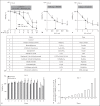Anti-Stress and Glial Differentiation Effects of a Novel Combination of Cucurbitacin B and Withanone (CucWi-N): Experimental Evidence
- PMID: 31000958
- PMCID: PMC6470339
- DOI: 10.1159/000490693
Anti-Stress and Glial Differentiation Effects of a Novel Combination of Cucurbitacin B and Withanone (CucWi-N): Experimental Evidence
Abstract
Background: Natural extracts and compounds used in traditional home medicine are known for their safety and a variety of health promoting and therapeutic potentials. In contrast to the single molecule mediated targets, the combinational therapies are preferred for their multi-functional and limited toxic regimens and may be useful for disease therapeutics as well as to increase the quality of life during a variety of environmental stresses.
Purpose: We aimed to combine the active ingredients of Chinese (Helicteres angustifolia) and Indian (Withania somnifera) ginsengs to develop a natural, efficient, and welfare combinatorial mixture with high anti-stress and glial differentiation potentials.
Methods: Using cultured cells as a model system, we developed a combination of active ingredients of Chinese (Cucurbitacin B [Cuc]) and Indian (Withanone [Wi-N]) ginsengs. Eleven chemical models of environmental stresses were used. Cytotoxicity studies were performed using human skin fibroblast for anti-stress and rat glioma cells for glial differentiation effects.
Results: We demonstrate that the novel combination of Cuc and Wi-N, CucWi-N, was non-toxic to normal cells. It caused stress protection in assays using normal human fibroblasts subjected to a variety of stresses. Of note, cells showed remarkable protection against oxidative and UV stresses and marked by decrease in DNA damage and reactive oxygen species. We examined and found the glial differentiation potential of CucWi-N in rat glioblastoma cells. CucWi-N clearly induced differentiation phenotype, well-marked with upregulation of GAP43, MAP2, and GFAP, which have been shown to play a key role in glial differentiation.
Conclusion: These data demonstrate anti-stress and glial differentiation potential of CucWi-N (a novel combination of Cuc and Wi-N) that could be recruited in nutraceutical and pharmaceutical avenues and hence warrant further evaluation and mechanistic studies.
Keywords: Cucurbitacin B; Glial differentiation; Stress; Therapeutics; Withanone.
Figures




Similar articles
-
Induction of Senescence in Cancer Cells by a Novel Combination of Cucurbitacin B and Withanone: Molecular Mechanism and Therapeutic Potential.J Gerontol A Biol Sci Med Sci. 2020 May 22;75(6):1031-1041. doi: 10.1093/gerona/glz077. J Gerontol A Biol Sci Med Sci. 2020. PMID: 31112603
-
Three-Way Cell-Based Screening of Antistress Compounds: Identification, Validation, and Relevance to Old-Age-Related Pathologies.J Gerontol A Biol Sci Med Sci. 2023 Aug 27;78(9):1569-1577. doi: 10.1093/gerona/glad103. J Gerontol A Biol Sci Med Sci. 2023. PMID: 37061830
-
Differential activities of the two closely related withanolides, Withaferin A and Withanone: bioinformatics and experimental evidences.PLoS One. 2012;7(9):e44419. doi: 10.1371/journal.pone.0044419. Epub 2012 Sep 4. PLoS One. 2012. PMID: 22973447 Free PMC article.
-
Neuropharmacological Properties of Withania somnifera - Indian Ginseng: An Overview on Experimental Evidence with Emphasis on Clinical Trials and Patents.Recent Pat CNS Drug Discov. 2016;10(2):204-215. doi: 10.2174/1574889810666160615014106. Recent Pat CNS Drug Discov. 2016. PMID: 27316579 Review.
-
Scientific basis for the use of Indian ayurvedic medicinal plants in the treatment of neurodegenerative disorders: ashwagandha.Cent Nerv Syst Agents Med Chem. 2010 Sep 1;10(3):238-46. doi: 10.2174/1871524911006030238. Cent Nerv Syst Agents Med Chem. 2010. PMID: 20528765 Review.
Cited by
-
Rat Glioma Cell-Based Functional Characterization of Anti-Stress and Protein Deaggregation Activities in the Marine Carotenoids, Astaxanthin and Fucoxanthin.Mar Drugs. 2019 Mar 23;17(3):189. doi: 10.3390/md17030189. Mar Drugs. 2019. PMID: 30909572 Free PMC article.
-
Anti-stress, Glial- and Neuro-differentiation Potential of Resveratrol: Characterization by Cellular, Biochemical and Imaging Assays.Nutrients. 2020 Feb 29;12(3):671. doi: 10.3390/nu12030671. Nutrients. 2020. PMID: 32121454 Free PMC article.
References
-
- Saunders LR, Verdin E. Cell biology. Stress response and aging. Science. 2009;323:1021–1022. - PubMed
LinkOut - more resources
Full Text Sources
Miscellaneous

